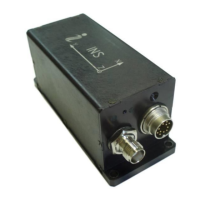INS
GUI User’s Manual
Inertial Labs, Inc
TM
Address: 39959 Catoctin Ridge Street, Paeonian Springs, VA 20129 U.S.A.
Tel: +1 (703) 880-4222, Fax: +1 (703) 935-8377 Website: www.inertiallabs.com
160
13. Synchronization of INS data with LiDAR and other
devices
Synchronization of the Inertial Labs
TM
INS measurements with data form
other devices is very important in many applications. The INS can trigger
other devices, or an external device can trigger the INS measurements.
To trigger external devices the Inertial Labs
TM
INS outputs accurate pulse
per second (PPS) signal generated by on-board GNSS receiver. The PPS
signal is provided by appropriate pin of the INS main connector (see INS
ICD, Table 5.1 and Table 5.2). The Inertial Labs
TM
INS GUI allows to adjust
the PPS signal -- see section “13.1. Control of PPS output signal”.
There are two ways to trigger the INS data from external device. At the first,
the INS can operate in the “On Request” (on demand) mode when the INS
sends one data block after each Request command issued from the host
computer. See INS ICD, section “6.3.2. SetOnRequestMode command –
getting INS data on request (on demand)” for details.
The second way of the INS data synchronization is using mark input line to
trigger the INS output data by external devices. Mark input line is connected
to appropriate pin (MARK IN pin) of the INS main connector (see INS ICD,
Table 5.1 and section “5.6. Mark input description”). Currently the mark input
is used to trigger GNSS raw data in INS. The Inertial Labs
TM
INS GUI allows
to adjust receiving of synchro pulses through mark input signal – see section
“13.2. Processing of mark input signal”.
13.1. Control of PPS output signal
The Inertial Labs
TM
INS outputs the pulse-per-second (PPS) signal
generated by GNSS receiver. PPS pulse is shown on the Fig. 13.1.

